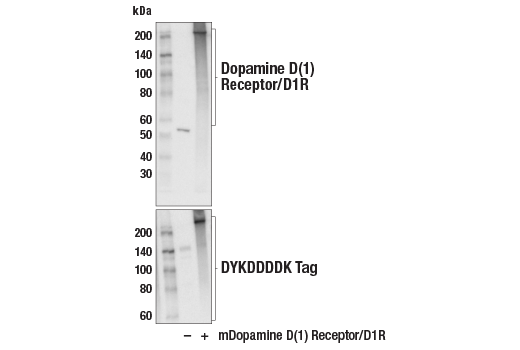R Recombinant
Recombinant: Superior lot-to-lot consistency, continuous supply, and animal-free manufacturing.
Dopamine D(1) Receptor/D1R (E3H3S) Rabbit mAb #79777
Filter:
- WB
- IF
Supporting Data
| REACTIVITY | M |
| SENSITIVITY | Endogenous (IF-F), Transfected (WB) |
| MW (kDa) | 60-210 |
| Source/Isotype | Rabbit IgG |
Application Key:
- WB-Western Blotting
- IF-Immunofluorescence
Species Cross-Reactivity Key:
- M-Mouse
- Related Products
Product Information
Product Usage Information
| Application | Dilution |
|---|---|
| Western Blotting | 1:1000 |
| Immunofluorescence (Frozen) | 1:100 |
Storage
Supplied in 10 mM sodium HEPES (pH 7.5), 150 mM NaCl, 100 µg/mL BSA, 50% glycerol, and less than 0.02% sodium azide. Store at –20°C. Do not aliquot the antibody.
Protocol
Specificity / Sensitivity
Dopamine D(1) Receptor/D1R (E3H3S) Rabbit mAb recognizes transfected levels of dopamine D(1) receptor/D1R by western blot and endogenous levels of total dopamine D(1) receptor/D1R protein in mouse brain tissue by immunofluorescence.
Species Reactivity:
Mouse
The antigen sequence used to produce this antibody shares 100% sequence homology with the species listed here, but reactivity has not been tested or confirmed to work by CST. Use of this product with these species is not covered under our Product Performance Guarantee.
Species predicted to react based on 100% sequence homology:
Rat
Source / Purification
Monoclonal antibody is produced by immunizing animals with a synthetic peptide corresponding to residues surrounding Val438 of mouse dopamine D(1) receptor/D1R protein.
Background
Dopamine is a neurotransmitter that plays important roles in the brain, particularly in dopamine pathways that control the motivational component of reward-motivated behavior. These behavioral outputs are generated by the basal ganglia via its interaction with multiple brain areas that modulate sensorimotor, emotional, and cognitive information (1). The brain’s major dopaminergic input is into the striatum, a region of the basal ganglia composed of GABAergic medium spiny neurons (MSNs). Two major subpopulations of MSN exist in the striatum that are distinguished by the expression of dopamine receptor subtypes, the dopamine D(1) receptor subtype and the dopamine D(2) receptor subtype (D1R and D2R, respectively) (2,3). As a family of proteins, dopamine receptors are a class of G protein-coupled receptors (GPCRs) consisting of 5 subtypes that, upon initiation, drive downstream signaling cascades that modulate neuronal function (1). Dopamine receptors form homo- and hetero-multimers with subunits within their protein family but also with other GPCRs, including Adenosine Receptor A2a, suggesting that dopamine receptor activity might be finely tuned and altered under certain conditions (4). Dopamine receptors have been studied as a therapeutic target for several neuropsychiatric and developmental disorders, as well as neurodegenerative diseases, including Parkinson’s disease (5-8). Dopamine receptors are also expressed outside of the brain and may have diverse functions beyond the central nervous system, including regulating innate and adaptive immunity (9).
- Beaulieu, J.M. and Gainetdinov, R.R. (2011) Pharmacol Rev 63, 182-217.
- Kebabian, J.W. and Calne, D.B. (1979) Nature 277, 93-6.
- Bertran-Gonzalez, J. et al. (2008) J Neurosci 28, 5671-85.
- Agnati, L.F. et al. (2016) Rev Neurosci 27, 1-25.
- Komatsu, H. et al. (2019) Int J Mol Sci 20, pii: E3207. doi: 10.3390/ijms20133207.
- Klein, M.O. et al. (2019) Cell Mol Neurobiol 39, 31-59.
- Hurley, M.J. and Jenner, P. (2006) Pharmacol Ther 111, 715-28.
- Stocchi, F. et al. (2016) Expert Opin Pharmacother 17, 1889-902.
- Vidal, P.M. and Pacheco, R. (2019) J Neuroimmune Pharmacol 19, doi: 10.1007/s11481-019-09834-5.
限制使用
除非 CST 的合法授书代表以书面形式书行明确同意,否书以下条款适用于 CST、其关书方或分书商提供的书品。 任何书充本条款或与本条款不同的客书条款和条件,除非书 CST 的合法授书代表以书面形式书独接受, 否书均被拒书,并且无效。
专品专有“专供研究使用”的专专或专似的专专声明, 且未专得美国食品和专品管理局或其他外国或国内专管机专专专任何用途的批准、准专或专可。客专不得将任何专品用于任何专断或治专目的, 或以任何不符合专专声明的方式使用专品。CST 专售或专可的专品提供专作专最专用专的客专,且专用于研专用途。将专品用于专断、专防或治专目的, 或专专售(专独或作专专成)或其他商专目的而专专专品,均需要 CST 的专独专可。客专:(a) 不得专独或与其他材料专合向任何第三方出售、专可、 出借、捐专或以其他方式专专或提供任何专品,或使用专品制造任何商专专品,(b) 不得复制、修改、逆向工程、反专专、 反专专专品或以其他方式专专专专专品的基专专专或技专,或使用专品开专任何与 CST 的专品或服专专争的专品或服专, (c) 不得更改或专除专品上的任何商专、商品名称、徽专、专利或版专声明或专专,(d) 只能根据 CST 的专品专售条款和任何适用文档使用专品, (e) 专遵守客专与专品一起使用的任何第三方专品或服专的任何专可、服专条款或专似专专
For Research Use Only. Not For Use In Diagnostic Procedures.
Cell Signaling Technology is a trademark of Cell Signaling Technology, Inc.
Alexa Fluor is a registered trademark of Life Technologies Corporation.
All other trademarks are the property of their respective owners. Visit our
Trademark Information page.


